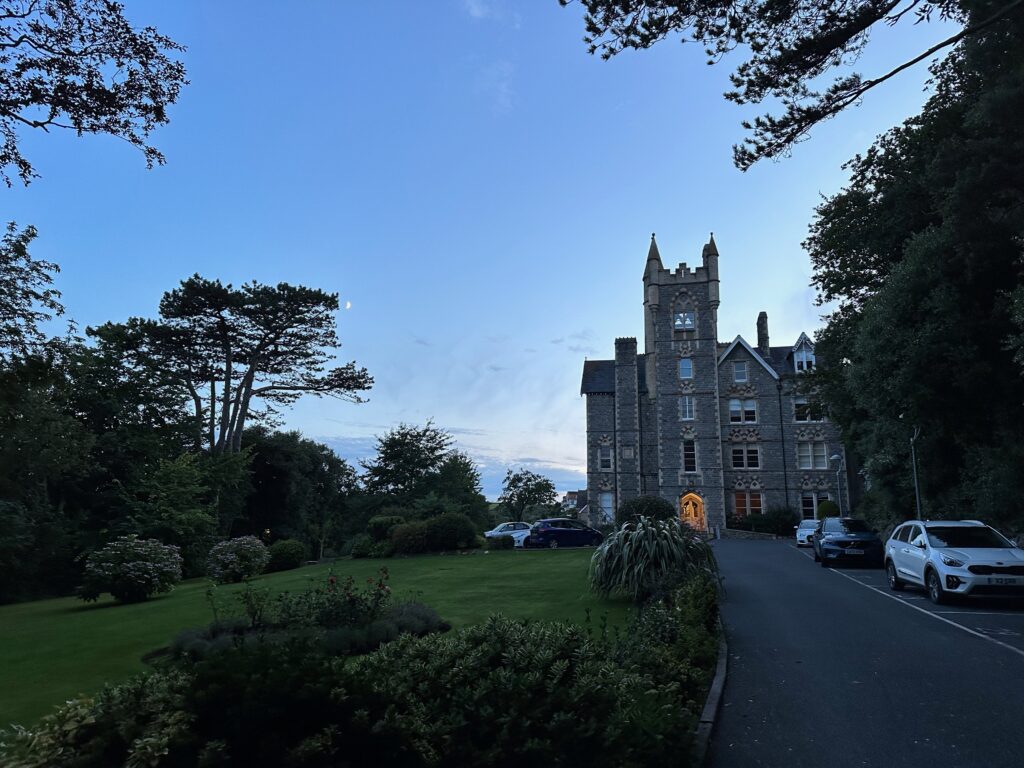from ‘a History of Mumbles’:
…

Langland Bay Manor’s life began as a private residence, ‘Llan-y-Llan Villa’
By far the most dominant building on Langland Bay, (originally called Longland Bay) constructed in the mid-nineteenth century and backing on to the Newton Cliffs, it was originally known as Llan-y-Llan. Built in dramatic Scottish Baronial style by Henry Crawshay, as his summer residence.
Henry Crawshay, grandson of Richard Crawshay the founder of Cyfarthfa ironworks, married Lisa Eliza Harris of Penderyn, one of the workers in the foundry. His family were totally opposed and so he distanced himself from them and in 1847 was transferred by his father to manage their Cinderford Works in the Forest of Dean. In the early 1850s, Henry decided to build a summer home for their growing family at Langland, which they moved into and named ‘Llan-y-Llan’ in August 1856.
The Langland Castle

Wendy Cope noted that at first the Imposing Gothic house was called Llan-y-llan but was later known as Langland Castle. He built Langland Bay Road to provide a good access to it. The family attended All Saints church and when one of their daughters died at Langland they caused a memorial window to be placed in the church. Henry became patron of Mumbles Athletic Sports and Mumbles Cricket Club. He also enjoyed sailing, each year being a patron of the regatta.
Mrs Crawshay joined with other local ladies and became a stall holder at charity events such as the Swansea Hospital Bazaar.
Mrs. Henry Crawshay was a benefactor of Newton School, where the log book records numerous visits by her between 1867 and 1882, usually between April and September each year, to hear the children answer questions in mental arithmetic and scripture. She “promised them a tea when the strawberries will be ripe” and on a summer afternoon in the years 1867-69 she had all the children to tea at Llan- y-llan, “a sumptuous treat”, and perhaps in other years not recorded.
In October 1869 she entertained the children of Newton and Bishopston schools combined, one hundred and twenty in number, to a mid-day meal of roast beef and plum pudding, followed later in the afternoon by tea and cakes “in the house” and on several occasions hosted the Swansea Ragged School treat.
Henry died in 1879 but Lisa Eliza lived on until 1887, after which the house was sold.
The Langland Castle Hotel
The Langland Castle, with its furniture and 77 acres of land were bought from the Crawshays Estate, by Mr Ludlow who formed a company with other gentlemen to develop the house as a grand hotel. The house was enlarged with a third floor added and as part of this plan for a hotel a drinks licence was granted in September 1888. The Langland Castle Hotel was opened with fifty rooms and fifty acres of land, the following year.
Langland Bay Hotel
Early in 1891 the hotel came under new management, it was renamed The Langland Bay Hotel and Miss Duffield was the new manageress. A year later it was for sale again, along with the farm.
An advertisement in the Western Mail in 1902 describes it as:
‘Winter resort by the sea charmingly situated in its own extensive grounds. South aspect, and entirely sheltered from the North wind and East winds. Tennis courts, billiard room, 75 bedrooms, hot and cold seawater baths on each floor. Excellent cuisine. Moderate tariff. The “Mentone” of Wales. Omnibus carries visitors free of charge from Swansea station to Hotel on advising Manageress, MISS LOGAN.
National Telephone 502. Telegrams, “Delight” Mumbles.
Supplies for the hotel were ordered from Swansea and sent to Mumbles on the steam train, from where hotel vehicles would collect them.
The Walters family, who owned the Park Hotel in Llandrindod Wells, bought the Hotel in or after 1904 for their daughter Julia, who married Mr Arthur Hart. In 1912 the hotel was managed by a German couple named Buttgen, but they were interned during the First World War and Mr Hart persuaded his sister, Mrs Murison, to take over as manageress and she filled that post until the hotel was sold in 1922.
Langland Bay Convalescent Home
The hotel was bought in 1922 by the Workingmen’s Club and Institute Union and became the Langland Bay Convalescent Home providing an opportunity for recuperation for many miners and other working men. In later years it also provided holidays for club members. In 1974 it was closed for a while for alterations and modernisation and the lodge at the entrance was demolished. At the beginning of 2004 the organisation decided to close the home as they were in financial difficulties. It was bought the following year by developers who have turned it into flats, Wendy.
Heather Sangster Davies, who worked there for many years, rising to the role of matron, noted that ‘before 1972 the home used to have 86 residents a week, most of whom came from Merthyr and had a mixture of Spanish, Italian and Irish names. The residents used 47 of the rooms, usually staying for a week and when they left, we had one day to get the rooms ready for a new intake.’
After their evening meal, the men usually went across to the New Langland Bay Hotel Restaurant (built next door) for a drink.
… and now:
Langland Bay Manor
